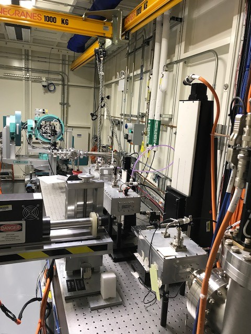Beamline for Material Measurement

Viewing downstream within the X-ray enclosure hutch at the Beamline for Material Measurement (BMM). In the foreground is the sample area for the X-ray Adsorption Fine Structure (XAFS) end station, with the 6 circle Ψ goniometer used in the X-ray Diffraction (XRD) end station in the background.
The Beamline for Material Measurement (BMM) employs a 3-pole wiggler insertion device to deliver a broad spectrum of hard X-rays (4.5 keV to 23.5 keV) into end stations that perform X-ray Absorption Fine Structure (XAFS) and X-ray Diffraction (XRD). BMM is one of three beamlines built through a partnership between NIST and Brookhaven National Laboratory that spans almost four decades. In addition, a partnership with IBM has supported the design, installation, and operations of the XRD end station.
The intense, broad spectrum beam in concert with XAFS and XRD end stations enables the determination of local and long range structure of a vast array of condensed matter with applications to many science areas, including chemical and energy science, materials science, electronic materials, earth and environmental sciences, and more. The spot size of the incident X-ray beam can be tuned to fit the application and end station, with an unfocused beam of 8 mm x 1 mm and focused beam below 300 microns. The beam is conditioned and delivered using a paraboloid collimating mirror, a monochromator with routine changes between the Si(111) and Si(311) crystal sets, a toroidal focusing mirror, and a flat harmonic rejection mirror.
Techniques/End Stations
X-ray Diffraction (XRD) - XRD has long been a foundational technique for the determination of crystalline structure in materials, with impact in nearly every sub-field of materials science. The installation of a six-circle Ψ goniometer on a bright, synchrotron source enables the determination of structural details not feasible in lab-scale analogs.
X-ray Absorption Fine Structure (XAFS) - The XAFS station provides the perfect complement to XRD by providing details of local structure such as the valency while also expanding the types of samples probed. Here, the high brilliance source enables the successful measurement of structure in materials with very low concentrations of dopants, irrespective of the matrix material or its form. As a result, the valency and environment of dopants can be measured in liquids, amorphous solids, crystals, liquid crystals, and other material forms in a straightforward manner.
Contacts
Beamline Scientists
-
(631) 344-3613
-
(631) 344-4247
-
Jean Jordan-Sweet (IBM)(631) 344-8581

